Best Caribbean diving: a guide to exploring tropical depths
The Caribbean is renowned for its crystal clear waters and stunning marine life, making it a top destination for scuba diving enthusiasts. Some of the best scuba diving spots in the Caribbean include the Cayman Islands, Bonaire, and the Bahamas, where you can explore shipwrecks, vibrant coral reefs, and encounter exotic sea creatures.
The Caribbean is widely celebrated for its scuba diving opportunities due to its crystal-clear waters, diverse coral reefs, and rich marine life. With over 7,000 islands, cays, and reefs, the Caribbean region presents an abundance of stunning underwater experiences for scuba divers. In this article, we will conduct an in-depth analysis of the finest Caribbean diving facilities. Our focus will be on the top dive spots and the marine life that is a must-see while exploring this remarkable region.
Why scuba diving in the Caribbean?
The Caribbean is indeed a scuba diver’s paradise, and this is due to the fact that there are numerous dive sites that cater to divers of different skill levels. Moreover, the warm and crystal-clear waters of the Caribbean Sea provide excellent visibility and ideal diving conditions. In addition to these favorable conditions, the marine life in the Caribbean is diverse and vibrant, boasting over 500 species of fish and countless other marine creatures.
Best time to scuba dive in the Caribbean
The Caribbean is a year-round scuba diving destination, but the best time to go diving depends on where you’re headed. Generally, the best time to go diving in the Caribbean is from December to April when the weather is dry and the water is warm. However, some destinations are better suited for diving during other times of the year.
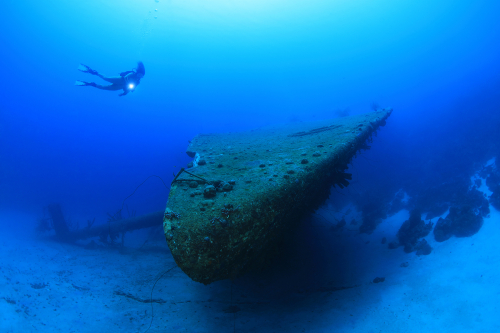
Best Caribbean diving spots
The Caribbean is renowned for being home to some of the most exceptional dive spots in the world. In fact, each of these dive spots has its unique underwater landscape and marine life, making them all the more exciting to explore. For those who are curious, here are some of the top dive spots in the Caribbean:
- The Bahamas. The Bahamas is a world-renowned diving destination, with over 700 islands and cays to explore. The waters around the Bahamas are home to an abundance of marine life, including sharks, rays, and turtles. The Bahamas also boasts the world’s third-largest barrier reef, the Andros Barrier Reef.
- Bonaire. Bonaire is a small island in the southern Caribbean known for its pristine reefs and crystal-clear waters. The island is surrounded by a marine park, making it an ideal destination for scuba divers. Bonaire is home to over 470 species of fish and 120 species of coral. And Bonaire has some of the best scuba schools in the world!
- Grand Cayman. Grand Cayman is the largest of the Cayman Islands and a top diving destination. The island is known for its dramatic drop-offs and colorful walls teeming with marine life. Grand Cayman is home to the famous Stingray City, where divers can swim with southern stingrays.
- Roatan. Roatan, a small island off the coast of Honduras, is a favored destination for divers. This island boasts the Mesoamerican Barrier Reef, which is the second-largest barrier reef globally, making it a prime spot for scuba diving enthusiasts. Roatan is known for its vibrant coral reefs and diverse marine life, including whale sharks, dolphins, and sea turtles.
- St. Croix. St. Croix, which is the largest of the U.S. Virgin Islands, is a leading destination for scuba diving enthusiasts. The island’s waters are teeming with an array of marine life, such as eagle rays, sea turtles, and nurse sharks. St. Croix is also home to the famous “Wall,” a steep drop-off that descends to over 13,000 feet.
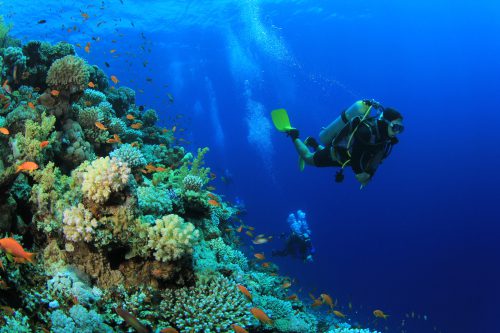
Must-see marine life while diving in the Caribbean
The Caribbean is home to a diverse range of marine life, from colorful fish to sharks and rays. Here are some of the must-see marine creatures to look out for when scuba diving in the Caribbean:
- Caribbean Reef Sharks. Given that Caribbean reef sharks are a common sight in the waters surrounding the Caribbean, it’s worth noting that these sleek predators, known for their curious nature, can grow up to 10 feet in length.
- Green Sea Turtles. Divers in the Caribbean frequently come across green sea turtles while they graze on seagrass beds. These gentle giants, which can weigh up to 400 pounds, are a joy to watch underwater and a familiar sight in the region.
- Spotted Eagle Rays. Spotted eagle rays are a familiar sight in the Caribbean due to their striking spotted patterns and graceful movements. While looking for food, these creatures can often be spotted gliding along the reef, making them an exciting find for divers exploring the area.
- Octopuses. Octopuses are masters of disguise and can change their color and texture to blend in with their surroundings. These intelligent creatures are a delight to spot while diving in the Caribbean.
- Barracudas. With their sharp teeth and streamlined bodies, barracudas are frequently spotted in the Caribbean, where they are apex predators. These lightning-fast creatures can grow up to 6 feet in length, making them an exciting sight for divers exploring the region.
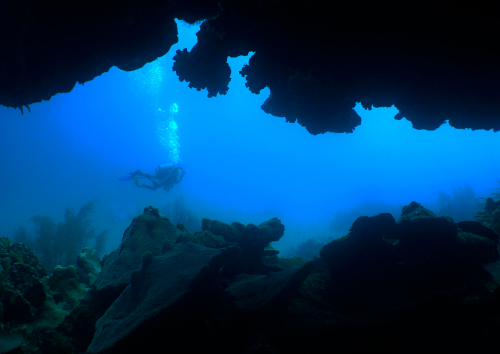
Best Caribbean diving safety
Scuba diving in the Caribbean is generally safe, but it’s essential to take the necessary precautions to ensure a safe and enjoyable dive. Here are some safety tips to keep in mind, but that of course apply to every diver in all regions of the world:
- Dive with a certified operator. When it comes to scuba diving, it’s crucial to prioritize safety above all else. That’s why it’s important to always choose a certified operator who follows industry safety standards and has a good safety record when planning a dive.
- Check your gear. Make sure your gear is in good condition and properly maintained before diving. Always check your equipment before entering the water.
- Monitor your air supply. Always keep an eye on your air supply and plan your dive accordingly. Don’t exceed your limits, and always ascend slowly and safely.
- Watch your depth. As you explore the depths of the Caribbean waters, it’s important to be mindful of your depth and stay within the recommended limits for your certification level. Going beyond your limits can be dangerous and increase your risk of decompression sickness. It’s important to remember that the deeper you dive, the shorter your no-decompression limits become, so always be aware of your depth and take appropriate measures to ensure your safety.
- Be aware of your surroundings. Always be aware of your surroundings and watch for potential hazards, such as currents, sharp rocks, and marine life. Don’t touch or disturb marine life, and avoid contact with coral reefs and other fragile ecosystems.
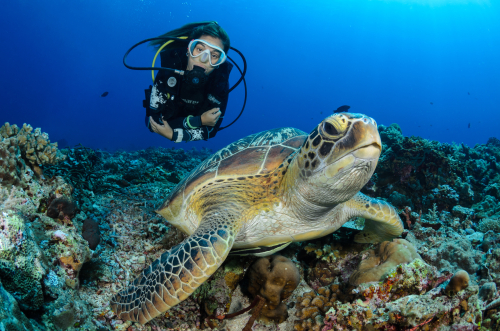
Sustainable diving in the Caribbean
As scuba divers, it is our duty to protect the fragile ecosystems that we have the privilege to explore. To ensure that we are engaging in sustainable diving practices in the Caribbean, there are several tips that we can follow. Here are some essential recommendations for sustainable diving in the Caribbean:
- Choose eco-friendly operators. Choose operators who prioritize sustainability and follow responsible diving practices. Look for operators who support marine conservation efforts and work to reduce their environmental impact.
- Minimize your impact. Minimize your impact on the environment by avoiding contact with marine life, taking only photos, and leaving only bubbles. Don’t touch or disturb coral reefs or other fragile ecosystems.
- Reduce your waste. Reduce your waste by using eco-friendly products and avoiding single-use plastics. Bring a reusable water bottle and refill it instead of buying bottled water.
- Support marine conservation efforts. Support marine conservation efforts by donating to reputable organizations or participating in reef cleanup programs. Be an advocate for sustainable diving practices and spread the word about the importance of protecting our oceans.
FAQs about best Caribbean diving
- What is the water temperature like in the Caribbean for scuba diving?
- The water temperature in the Caribbean ranges from 78-84°F (26-29°C) year-round.
- Do I need to be a certified scuba diver to dive in the Caribbean?
- Yes, you need to be a certified scuba diver to dive in the Caribbean. However, there are many dive operators who offer certification courses for beginners.
- What should I wear while scuba diving in the Caribbean?
- While scuba diving in the Caribbean, you should wear a wetsuit, fins, and a mask. It’s also recommended to wear a rash guard or dive skin to protect your skin from the sun.
- How long does it take to become a certified scuba diver?
- It typically takes 3-4 days to become a certified open water scuba diver. However, the length of the course may vary depending on the dive operator and the student’s pace.
- Can I rent scuba diving equipment in the Caribbean?
- Yes, most dive operators in the Caribbean offer equipment rental. However, it’s recommended to bring your own gear if possible for comfort and familiarity.
- Are there any age restrictions for scuba diving in the Caribbean?
- Yes, there are age restrictions for scuba diving in the Caribbean. Generally, the minimum age for scuba diving is 10 years old. However, some dive operators may have higher age restrictions or require a minimum level of certification.
- What is the maximum depth for scuba diving in the Caribbean?
- The maximum depth for scuba diving in the Caribbean depends on your level of certification. For open water divers, the maximum depth is typically 60 feet. However, more advanced divers with higher certifications may be able to dive deeper.
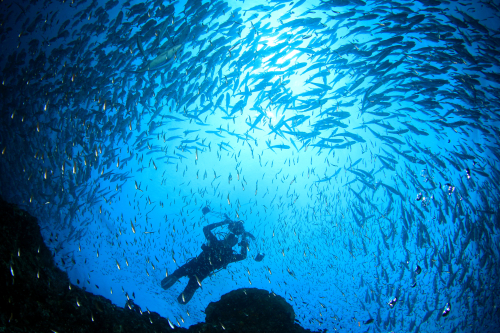
Final thoughts about best Caribbean diving
Scuba diving in the Caribbean is an experience that every diving enthusiast must try. With a wide variety of dive sites and marine life to explore, it’s easy to see why the Caribbean is such a popular destination for divers. However, it’s important to dive safely and responsibly to protect the fragile ecosystems that we explore. By following safety guidelines and practicing sustainable diving, we can ensure that future generations can continue to enjoy the beauty of the Caribbean’s underwater world.
Whether you’re a beginner or an experienced diver, the Caribbean has something to offer for everyone. From the breathtaking coral reefs of Bonaire to the famous Stingray City in Grand Cayman, there’s no shortage of dive sites to explore. And with the warm, clear waters and vibrant marine life, you’re sure to have an unforgettable diving experience.
But diving in the Caribbean is not without its risks, and it’s important to be aware of the potential hazards. Strong currents, sharp rocks, and potentially dangerous marine life such as sharks and barracudas are all possible risks that divers should be prepared for. It’s important to dive with a certified operator and always follow industry safety standards to minimize these risks.